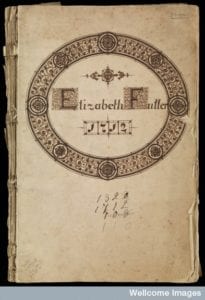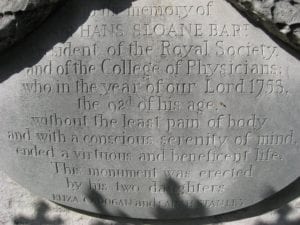The terror of smallpox lives on in popular memory, but measles are often dismissed by many as just a childhood disease: How much harm could it really cause? And aren’t childhood diseases useful for breaking in immune systems anyhow? We overlook measles at our peril, as recent outbreaks, such as the Disneyland one, have shown. It only takes one sick person for the disease to spread rapidly among those who can’t be vaccinated (such as babies), those whose vaccines are incomplete or unsuccessful, and those who opted out of vaccination.
But is measles really comparable to smallpox, or am I being a bit extreme? Well, in early modern Europe, measles—more specifically, its complications–was considered as deadly as smallpox.

Credit: Wellcome Library, London.
In 1730, physician Thomas Fuller published Exanthematologia: Or, An Attempt to Give a Rational Account of Eruptive Fevers, especially of the Measles and Small Pox. Fuller addressed it to Sir Hans Sloane and the Royal College of Physicians. In part, this was a strategy to situate the book as part of the reformed and rationale medicine that Sloane championed as the College’s President.
But it would have appealed to Sloane who had promoted smallpox inoculation and had a longstanding interest in fevers. Not only did he help to popularise the use of Peruvian bark for treating fevers, regularly using it in his own practice, but he took an interest in the publication of Edward Strother’s Criticon Febrium: or, a critical essay on fevers in 1716 (Preface). Strother, perhaps not coincidentally, was also a fan of Peruvian bark (48).
Fuller classified and described the various types of fevers with rashes or pustules, concluding that the most dangerous were smallpox and measles. Although the two diseases were very different, they had something crucial in common, being contagions that could be spread through one’s breath or skin pores (93). These “venemous fevers” were produced by a venom that was mild, unless over-heated—then the fevers became “more killing than even the Plague itself” (119).
Measles, even in its most benign state, is a miserable experience. The symptoms include: coldness and shivering; yawning; queasiness and vomiting; anguish; headache and backache; quick and weak pulse; great heat and thirst; short, painful breathing and oppession of the breast; hypochondriac tension and pale urine; watchfulness and drowsiness; convulsions; weakness and heaviness; redness, swelling, and pricking of eyes, lids and brows; involuntary tears and sneezing; sore throat, hoarseness, runny nose, and perpetual cough (142).
Fuller noted that not only did the cough always come before the measles, but that the pain in one’s chest and shortness of breath were much worse in measles than smallpox (147-8). Measles could also become malignant, or as we’d call it today, develop complications. The fever would last longer than four days and the spots would erupt much more slowly. Worse yet, diarrhea and peripneumonia occurring afterwards could prove fatal (149-150). At this point, Fuller included excerpts from Thomas Sydenham’s observations of measles outbreaks during the 1670s (151-7).

Death carries off a child on his back. Etching by Stefano Della Bella, Credit: Wellcome Library, London.
It is Sydenham’s references to the personal devastation from the illness that caught my attention. In 1670, measles “seiz’d chiefly on Children; but spar’d none in any House they enter’d into” (151). By day 8, the spots cleared up, as was typical, but that is when the cough set in: “we are to observe, that at this Time the Fever, and Difficulty of Breathing are increased; and the Cough grown so cruelly troublesome, as to hinder Sleep Day and Night”. The cause of the children’s terrible coughs, Sydenham suggested, was poor management of the disease; they had “been kept too hot, and have taken hot Medicines, to drive, or keep out the Measles” (153). As we know now, complications are more likely to happen in people who have chronic conditions, the very young or elderly, and the malnourished.
So, how did Sydenham and Fuller treat measles? With “much the same Method of Cure with the Small-pox”. Not surprising, given that they were both classed as venomous diseases. Above all, “hot medicines and regimen are extreamly pernicious”. The patient should “eat no flesh”, only water-gruel, barley-broth and roasted apples (sometimes). To drink, the patient was allowed small beer or watered down milk. The patient was to remain in bed for two to three days during the eruption, so the morbose particles would leave through the skin (155-6).
The cough should be treated with a pectoral decoction, linctus and diacodium (poppy syrup): “Very rarely, if ever, will any one that useth this Method die”. If the cough continued, it could “bring great Danger”. Bleeding was the clear choice in that case. “I have (with great Success)”, Sydenham promised, “order’d even the youngest Infants to be let Blood in the Arm; and where the Case requir’d it, I have not fear’d to repeat the same.” This rescued “truly many Children that have been at Death’s Door”. As a bonus, bleeding treated the diarrhea by ridding the body of sharp humours (156-7).
No wonder measles was so feared, with Sydenham declaring that the pneumonia “is so fatal commonly after the Measles, that it may well be reckon’d the chief Minister of Death, destroying more than even the Small-Pox itself” (157). They didn’t know yet about the potential for brain damage or deafness! In the West, we’ve forgotten the real horror of epidemic diseases that killed children.
For some other historical discussions of measles, see The Wellcome Trust Blog on the development of vaccination programmes and Historiann on the early eighteenth-century treatments proposed by Cotton Mather.




